BACK TO ESSAYS
A Journalist’s Guide to Getting the Most from the Quilt Index
For journalists and researchers who are new to this rich resource on quilt history, welcome. If you’re already familiar with the Quilt Index, pardon me while I give a description of this extensive and fast-growing archive to the others.
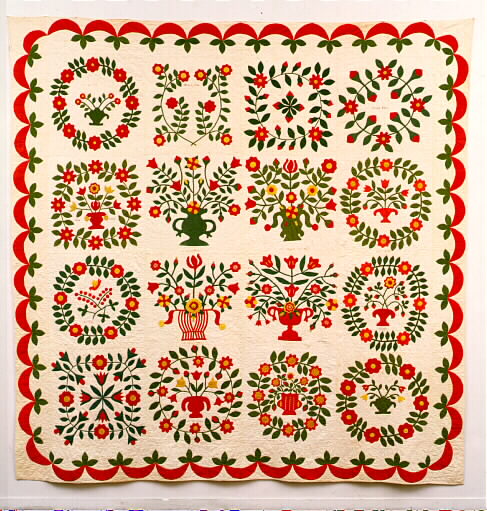
Baltimore Album
Believed to have been made by Ruth Penn
Elkridge Landing, Maryland
c1850
Collection of the DAR Museum acc.#92.172
The quilt is believed to have been made by Ruth Penn for her son Thomas on the occasion of his marriage.
Here at the Quilt Index, tradition meets technology head-on, allowing you to use your computer to see and study more than 52,000 quilts from four centuries. Some of the 30-plus collections archived at the Index are museum collections, from fine institutions like the D.A.R. Museum in Washington, D.C. and the National Quilt Museum in Paducah, Kentucky. Even if you visit those museums, there is no guarantee that you’d get to see the precise quilts you want to see, because at any one time, most of the quilts will be in storage rather than on view. This site allows access to thousands of museum quilts without an admission fee, 24/7.
But the majority of the collections available on the Index are truly virtual collections. They consist of quilts from state documentation projects, a practical method of preserving quilt history that has swept the nation in recent decades. The way these work, quilts in a given state are brought to central locations and documented by cadres of local volunteers. If the state organizers decide to apply to the Index to submit their project, then later, some of the quilts are archived not just in local books and records, but here as well.
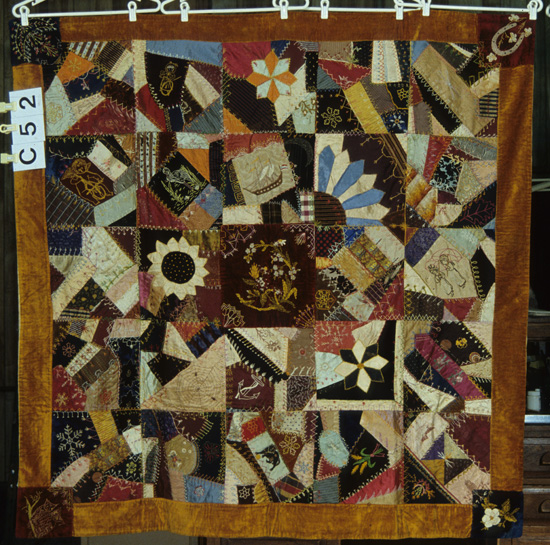
Crazy Quilt
Maker unknown
1875-1900
Private Collection
Often, a state project takes years to complete, so these quilts were never all together: in Iowa as an example, more than 500 volunteers worked on the Iowa Quilt Research Project, covering 13 regions around the state. After their day in the spotlight, the quilts disappear, swept back into the attics and basements and bedrooms from which they emerged. But on the Index, they can live permanently, and share their stories.
The remaining quilts archived at the Index are from private quilt collections, a part of the online mix that is targeted for future growth. One new model for showing and sharing private quilts on the Index is evidenced by the Signature Quilt Project, which allowed “public submission” of quilts by families wanting to share their signature quilts. The red and white quilt pictured, made in 1906, is covered with about 833 signatures, and all those names are documented on the Index.
Depot Harbor Signature Quilt
Ladies Aid Society
Depot Harbor, Ontario, Canada
1906
Private Collection
The family lore stated that it had been made by "grateful parishioners" at Rev. Miller's first church of 15 that he founded during his career.
There are about 60 quilts posted so far in the Signature Quilt Project, and what’s remarkable is that the Index makes it possible to search not only these, but to also compare them to the more than 2,000 signature quilts online that are part of other collections.
Still another big milestone for the Index is a recent move to go global: quilts from Canada and South Africa are among the first international quilts to be added, but many more will be added in coming years.
The growth and diversity of this archive, since it went live online in 2003, is nothing short of phenomenal, and the continuing additions of fresh material will only make it more vital.
What Makes the Index So Valuable to Journalists?
This archive is unique: nowhere else will a journalist or other researcher have access to this many quilts. No single museum can compete with the breadth and depth of what the Index offers. You can study the gorgeous Hawaiian style of quilting in depth by looking at the Hawaiian Quilt Research Project with its 1,200 quilts made before 1959.
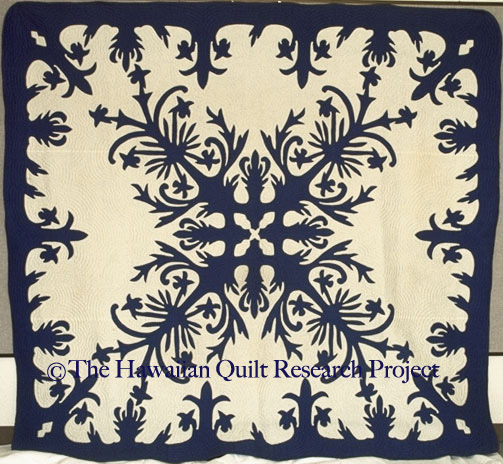
Orchid
Virginia Jacinth appliquér, Juliette Oliveria Wong, quilter
City, County, Michigan
Date
Private Collection
Here’s one vivid example, or you can search for, say, crazy quilts across all the Index collections, and see nearly 2,500 examples from many regions and periods.
In addition to scope, the Index offers authority and thoroughness: the documentation forms were created by scholars and are quite detailed. If those recording the data know who made the quilt, what materials she (or he) used, when and where she made it, and other details of historical interest, they’ll be accessible along with a photo. If there is a back story, often one that illuminates not just how folks made quilts, but how they lived and cared for others, it will be part of that quilt’s documented record. Unlike many of the quilts that you might come across at an antique shop or flea market, all the quilts were vetted in multiple ways and come with documentation that you can trust.
Permissions Alert
But I’ll tell you what the Quilt Index is not: a clip art service, where you can download and reproduce any quilt image you fancy, and use it however you wish. I’ve been a working journalist for my whole career, so I know that journalists are always in a hurry and they want news and images they can use pronto. In today’s digital world, the deadline is this minute. However, the copyrights for quilt images on the Index remain with the museum or other institution that owns them: they can only be used by the Quilt Index for non-commercial, educational purposes.
This isn't to say there isn't a process for getting permissions. If you want to reproduce an image or try to find out additional information, contact Beth Donaldson, donald20@msu.edu.
If the image is from a museum, it may be most efficient to contact that museum's press office directly. For permission to use a quilt from a state documentation project, you can submit a request to use an image through the Quilt Index Contact Page or contact the project directly. When requests are received through the Contact Page, the request is forwarded to a contact person at the project.
One of the few exceptions to the no-permissions rule is the Quilt Alliance. The Alliance, along with Matrix: The Center for Humane, Arts, Letters, and Social Sciences Online, is one of the two partners who manage the Index, and it also operates other projects to preserve quilt history. The QA quilts posted on the Index at this point are small, contemporary quilts made for an annual quilt contest the Alliance runs to raise funds. As such, they provide a good showcase of what styles and techniques are popular with 21st century quilters, and journalists can publish these images without permission. To publish a contest quilt from the Alliance, simply cite the quilt as follows: Title, artist, created for the Quilt Alliance annual quilt contest in [year]. For more details on the Alliance, go to https://quiltalliance.org/, or contact executive director Amy Milne, info@quiltalliance.org.
An Overview on Effective Ways to Search the Archive
Part of what makes the Index so useful is that there are many good ways to search and navigate. At the top of your screen is a small box with the words Search Records above it: this is a keyword search that will search all 52,000 quilts on the Index to find what you want.
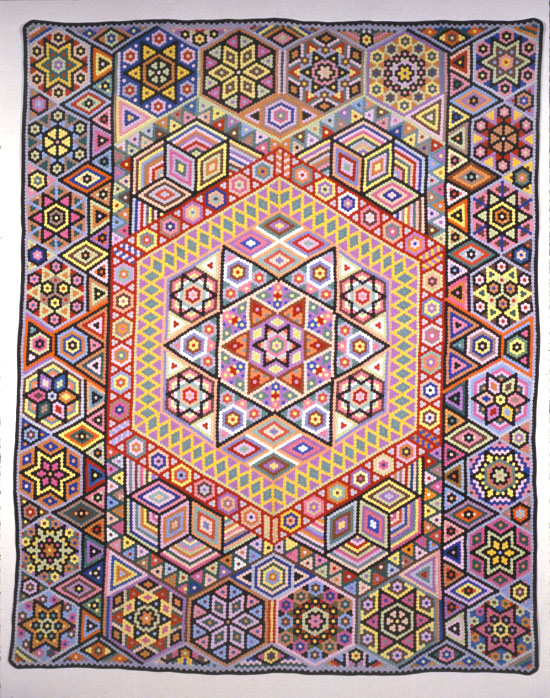
Mosaic 1
Albert Small
Ottawa, Illinois
1933-1934
Collection of the Illinois State Museum acc.#1992.51.1
Small was a dynamite handler for a quarry.
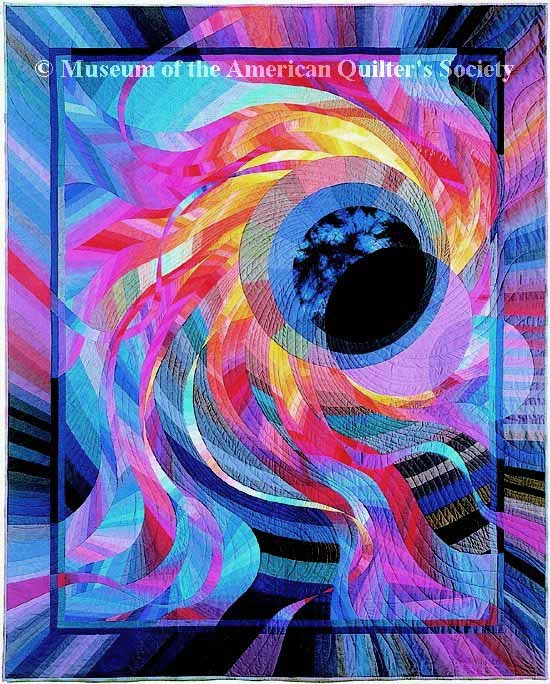
Corona II: Solar Eclipse
Caryl Bryer Fallert
Oswego, Illinois
1989
Collection of the National Quilt Museum Museum acc.#1996.01.07
National Quilter's Association (NQA) Master Quilter Status was conferred on Fallert in 1986.
Say you type in the name of a famous quiltmaker – such as Albert Small, renowned for making hexagon quilts with a bazillion tiny pieces, or a modern A-list art quilter like Caryl Bryer Fallert. You won’t need to know that Albert Small’s works are in the Illinois State Museum, or that Caryl Fallert’s are owned by the National Quilt Museum.
Just below that box, if you click on Advanced Search, you can limit and define your search more explicitly: examine Baltimore Album Quilts made in the 20th century, or search for quilts made from feedsacks during the Depression.
If you just want to start browsing, one great method is to click on Contributors and scroll down the list until you see a museum or state project that piques your interest.
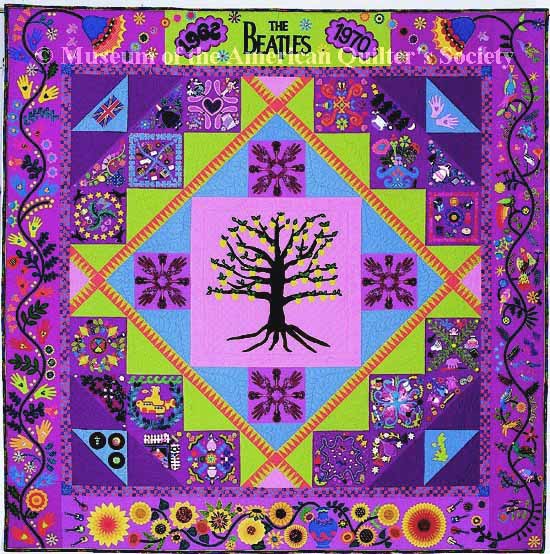
The Beatles Quilt
Pat Holly and Sue Nickels
Muskegon and Ann Arbor, Michigan
1998
Collection of the National Quilt Museum acc.#1998.01.01
Holly and Nickels are sisters who were big Beatles fans growing up.
If it is contemporary quiltmaking that you wish to research, the National Quilt Museum is a good bet: although its founders own some stunning vintage quilts, the museum collection consists mostly of quilts that won the top prizes at the annual American Quilters Society show in Paducah, Kentucky. This is a good way to get a sense of how dramatically quiltmaking has changed in this country since your grandmother’s day: as attested to by “The Beatles Quilt” by sisters Pat Holly and Sue Nickels, which won Best of Show in 1998.
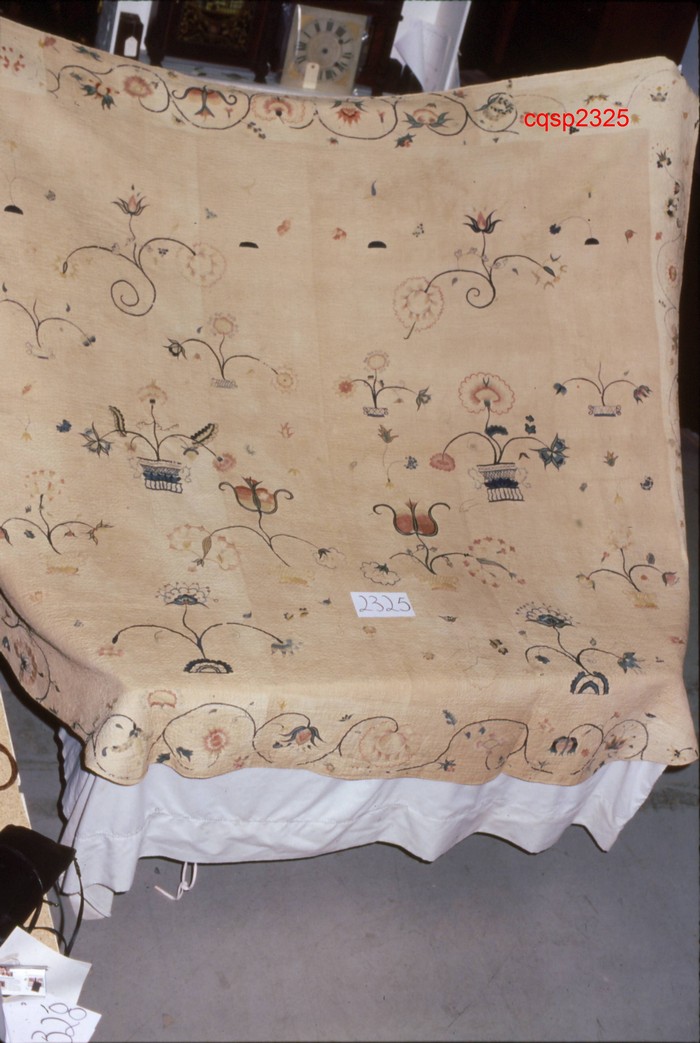
18th Century Crewel
K. W. Fox
Hampton, Connecticut
pre-1799
Private Collection
K W Fox Hartford, CT. appears on a label. "RF" is cross-stitched.
Quilts made before 1799 are very rarely still around to see. On the Index, you’ll find 163 of them (as of August 2011) and counting. They are often faded and worn, and not as bright or heavily embellished as many later types of quilts. But the Index will give you a good feeling for what they looked like and how they were made. Here’s one with hand embroidered crewel work that was uncovered by the Connecticut Quilt Search.
Another simple way through the materials is to click on Browse in the toolbar, which allows you to search the entire database by state, style of quilting, pattern and more.
There are also a number of essays and galleries posted here (including this one), that help to curate these vast resources and highlight different trends and aspects of history across the different collections. These might suggest story and slideshow ideas for your publication, so keep checking back for new ones.
Tech Tools That Let You Zoom & Compare
Photographs of the quilts on the Index were submitted by their contributors and reflect the different circumstances in which they were taken, which means that while many are sharp, high resolution beauties, a good number were taken during quilt documentation days by volunteers with varying lighting quality and resolutions, while others were taken by professional photographers in studio settings. Also, keep in mind that while many of these quilts are museum masterpieces or prize-winners, the majority are simply everyday quilts created by ordinary quilters. And that’s exactly what makes this such an important resource: you can study the exceptional quilts as well as the everyday utility quilts made by women (mostly) from coast to coast across the centuries.
Keeping that in mind, there are some terrific tech tools on the Index that will allow you to go both broader and deeper, to see more quilts at one time when you want, then focus on one and zoom in close to check the embellishment or read a signature.
When searching within a given collection, you can click on Read More, which provides background about that collection, or View Quilts. The latter automatically sets you up with a list of 10 quilts, telling you when the quilt was made, the quiltmaker and location of the quilt and giving you an option to get the detailed full record, or just basic information about each quilt.
Granted, the thumbnail photos are quite small, but if you click on the image, it will immediately be magnified. If you click on Basic Info, you’ll get a bigger image of that quilt, plus you will see a little square in the center of the image that’s a zoom tool. Click on that square, and you can navigate it across the surface of the quilt: a partial image underneath the full quilt will give you the close-up view.
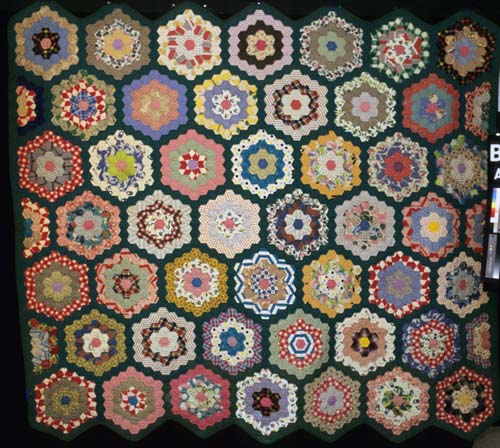
Flower Garden
Luella A. Stamm Hansen, piecer; quilter unknown
Dundy, Nebraska
1960-1977
This quilt was made for a teacher.
Here is one example: a quilt made in 1960 that’s part of the Nebraska Quilt Project. Click on the bottom lower left corner, then click on the + in the upper left corner to use the zoom feature.
You can use the compare feature. On the right hand side of each quilt entry is a box labeled "Click to Compare." Go through the collection of quilts and click on those you want to compare side by side on the same screen. You can even compare quilts in different collections. Once you’ve checked any number of quilts, Click Compare in the drop down menue in the upper right corner. You’re now ready to study them as a group.
A Few of My Favorite Quilts, with Great Stories to Match
I hope that this tutorial helps you find your way around the Quilt Index, but before I go, I wanted to share a few special favorites of mine, not just beautiful quilts, but fascinating stories. The Index saves both.
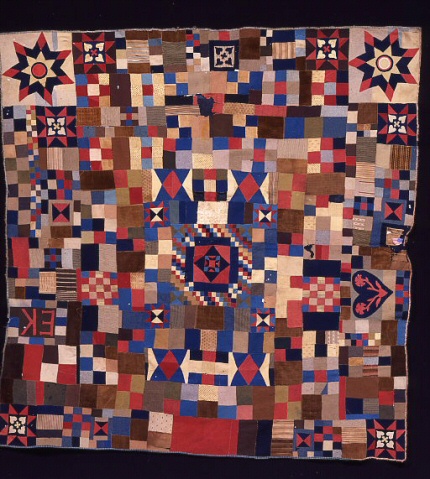
The Harper's Ferry Quilt
Elizabeth Kobler
Washington County, Maryland
c1790
Collection of the DAR Museum acc.#91.325
The Harper’s Ferry Quillt, is a special favorite both because of its link to a milestone moment in American history, and because it’s a stunning quilt. It was made from leftover scraps of fabric that had been used to make Revolutionary War soldier uniforms. The wife of tailor Barnette Kobler pieced it together around 1778.
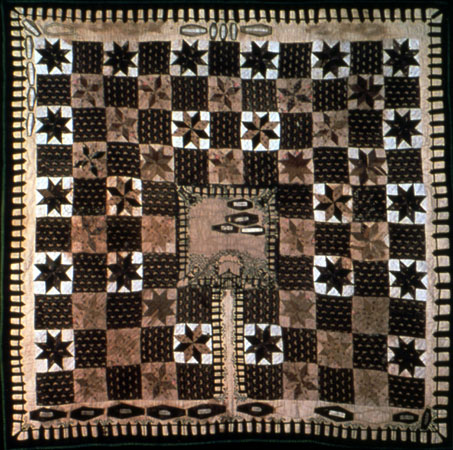
The Graveyard Quilt
Maker unknown
1850-1875
Private Collection
The Graveyard quilt was cataloged during the Kentucky Quilt Project, the first state documentation project in the country. This was made between 1850 and 1875, and depicts a family graveyard. There is a graveyard in the center of the quilt, and "extra" coffins displayed along several borders. It is assumed that when a family member died, a coffin was moved from the edges, and sewn down in the center.
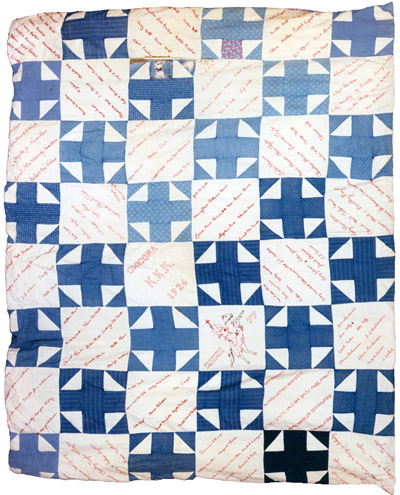
Ku Klux Klan Quilt
Various community members
Chicora, Michigan
1926
Collection of the Michigan State University Museum acc.#2000:71.1
The KKK quilt is owned by Michigan State University Museum and was made in that state in 1926, as a fundraiser for the KKK. People paid 10 cents for the privilege of signing this quilt. The story behind the quilt and the family that owned it are all in the Index documentation, as well as a full list of signers. Some people find this quilt creepy because of the KKK connection and it certainly isn’t a pretty piece. I include it to show that quilts aren’t just blankets or works of art, but also historical documents. This is one of many in the Index that espouses a cause and was used to raise funds for that cause.
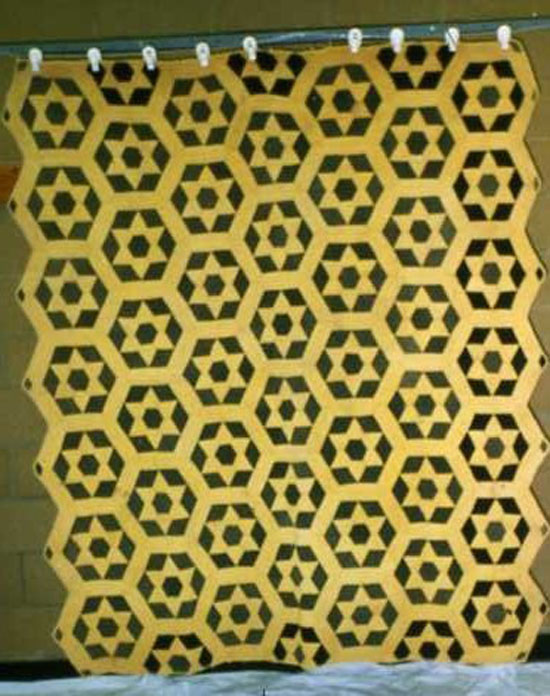
Star Bouquet
Nannie Long
Lehigh, Oklahoma
1934-1935
Private Collection
Nannie Long’s Incredibly Frugal Quilt was brought to the Wyoming Quilt Project and though it isn’t pretty, it tells a pithy tale of the period. It was made in Oklahoma in 1934, from used tobacco sacks, which the quiltmaker dyed herself “using yellow chips from a downed Bois’d’arc tree.” She also made the batting, from cotton she picked, and you feel a little bragging in the statement “the total cost of making this quilt was 65 cents.
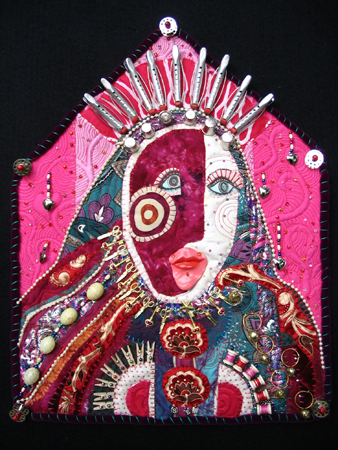
Icon-Domestic Goddess
Pamela Allen
Kingston, Ontario, Canada
2006
Private Collection
To end this string, it’s time for a cheerful, bright and modern quilt, so I give you this one, made by Canadian art quilter Pamela Allen. She is fond of putting all sorts of wild embellishments on her quilts, in this case including actual hair curlers. This was one of the contest quilts made for the Alliance for American Quilts, in 2006 when the contest theme was “Put a Roof Over Our Heads” and all the contest quilts were house-shaped.
Hidden Treasures, like the Quilt Index “wiki”
http://www.quiltindex.org/~quilti/wiki/index.php/Main_Page
That’s a lot to digest, but for those who like to go deeper, here’s one last wrinkle worth exploring. At the top toolbar, click on Wiki. The Wiki section of the Quilt Index is built on a wiki technology (the same software as Wikipedia). Anyone can register for an account and contribute information to this resource. This is an especially good place to see what’s bubbling up under the surface in the world of quilt history and documentation. Such as state documentation projects that are underway but not on the Index: you can search by state. There is also a list of quilt collections not just in the U.S. but worldwide. New resources keep getting added, and here’s a fun one: “Quilts & Social Media” provides links to quilt blogs, apps and social networks.
As you can tell, the Quilt Index is a work in progress, changing and growing rapidly.
Contact:
Meg Cox is a veteran journalist and author whose career includes 17 years on staff at the Wall Street Journal, where her beats included the business of the arts. A quilter for more than 20 years, her published books include The Quilter’s Catalog: A Comprehensive Resource Guide (Workman, 2008). She is a past president of the nonprofit Quilt Alliance.
www.megcox.com
meg@megcox.com
IMPORTANT NOTE TO JOURNALISTS:
This is the official boilerplate language to describe the Quilt Index. Please include this in anything you write about the project.
The Quilt Index is a joint project of MATRIX: Center for Humane Arts, Letters and Social Sciences Online at Michigan State University and the Quilt Alliance. The project has been supported in part by major grants from the National Endowment for the Humanities and the Institute for Museum and Library Services.
Meg Cox
Quilt Alliance, 2010
All rights reserved.
-Updated By Beth Donaldson, 5/27/2020
-
Documentation Project
Quilt Alliance -
Museum
DAR Museum DAR Museum
-
Documentation Project
Iowa Quilt Research Project State Historical Society of Iowa
-
Documentation Project
Signature Quilt Pilot Project Michigan State University
-
Documentation Project
Hawaiian Quilt Research Project Kalihi-Palama Culture and Arts Society
-
Museum
Illinois State Museum Illinois State Museum
-
Museum
National Quilt Museum -
Documentation Project
Connecticut Quilt Search -
Documentation Project
Nebraska Quilt Project University of Nebraska-Lincoln
-
Documentation Project
Kentucky Quilt Project University of Louisville
-
Museum
Michigan State University Museum Michigan Quilt Project
-
Documentation Project
Wyoming Quilt Project, Inc. -
ca. 1850
Baltimore Album Q... Penn, Ruth
-
1876-1900
Crazy Quilt -
1901-1929
Depot Harbor sign... -
ca. 1950
Orchid Pattern Ha... Jacinth, Virginia
-
1934
Mosaic 1 Small, Albert
-
1989
Corona II: Solar ... Fallert, Caryl Brye...
-
1998
Beatles Quilt, Th... Holly, Pat
-
Pre-1799
18th Century Crew... Unknown, Clarissa
-
1977
Flower Garden Hansen, Luella A. S...
-
ca 1790
Nontraditional Kobler, ELizabeth
-
1850-1875
Graveyard -
1926
Chicora KKK Quilt... Ku Klux Klan, Chico...
-
1935
Star Bouquet Long, Nannie
-
2006
Icon-Domestic God... Allen, Pamela
Load More